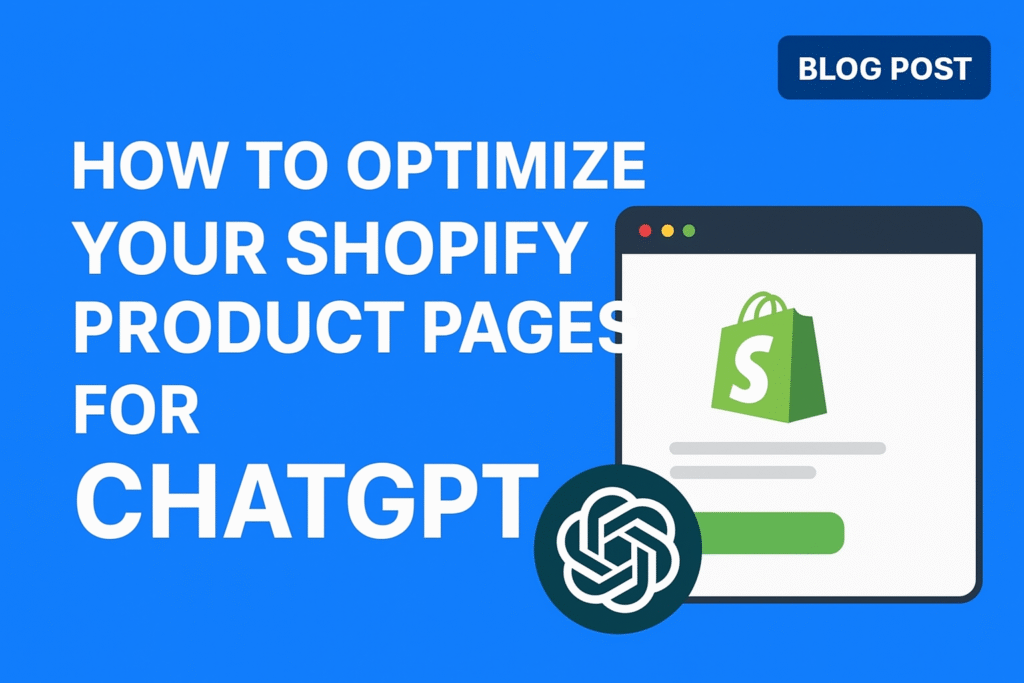Introduction: The Dawn of ChatGPT-Led Shopping
AI is transforming how people shop — and ChatGPT Shopping is at the forefront of that change. Customers are beginning to ask natural-language questions like “What’s the best moisturiser for dry skin?” or “Find me eco-friendly candles under £30,” and ChatGPT is already starting to surface curated, buy-ready product suggestions directly inside conversations.
For Shopify merchants, this represents a major shift. Traditional SEO still matters, but the next era of visibility depends on how well your product pages communicate with AI systems. If your product data isn’t structured for ChatGPT or your descriptions aren’t conversational enough, your store risks being invisible in this new ecosystem.
In this guide, we’ll walk you through how to optimise your Shopify product pages for ChatGPT — so your products can be understood, recommended, and purchased through conversational AI.
In this article, you’ll learn:
- What ChatGPT Shopping means for Shopify stores
- How to optimise your product data, schema, and content for AI understanding
- How to leverage reviews and site speed for visibility
- How to prepare your team for the AI-driven commerce era
What Is ChatGPT Shopping and Why It Matters for Shopify
ChatGPT Shopping is OpenAI’s first major step into the world of commerce. It allows users to ask questions like “Find a vegan leather handbag under £150” — and receive tailored product recommendations directly inside ChatGPT.
Leaked code and merchant beta programs suggest that Shopify integration is on the horizon. Soon, ChatGPT will likely be able to pull live product data from Shopify stores, display options in the chat, and even link directly to checkout.
That means discovery is moving away from search engines toward chat-based interfaces — and your Shopify product pages must be structured for AI comprehension, not just keyword crawling.
How ChatGPT Chooses Which Products to Display
Unlike traditional search engines, ChatGPT doesn’t simply look for keywords. It analyses context, meaning, and structure to determine which products best match a user’s intent.
Key signals include:
- Complete, accurate product data — clear titles, full descriptions, and detailed attributes.
- Structured schema markup — Product, Offer, and Review schema that define content relationships.
- Conversational, intent-matched content — aligned with how people ask real questions.
- Trust signals — reviews, ratings, and reliable data.
- Feed readiness — clean, standardised product feeds that can integrate into AI platforms.
The clearer and more consistent your data is, the more likely ChatGPT will understand and recommend your products.
Optimising Product Titles and Descriptions for ChatGPT
Your product titles and descriptions are now the way AI understands your catalogue — so clarity, specificity, and tone matter more than ever.
Best Practices:
- Use specific, detailed titles that include attributes like size, colour, material, and purpose.
- Write natural, conversational descriptions that read like human dialogue — not keyword blocks.
- Add FAQ-style content directly within the product description to anticipate common buyer questions.
- Focus on contextual storytelling — how and why someone would use your product.
- Include semantic variations and synonyms to help AI interpret meaning beyond exact matches.
Example: Instead of “Running Shoes,” write “Men’s Lightweight Trail Running Shoes – Waterproof, Size 10.” This gives AI richer context to interpret and surface your product accurately.
Implementing Structured Data (Schema) for ChatGPT Readiness
Schema markup is one of the strongest signals you can send to AI systems. It acts as a bridge between your Shopify product pages and ChatGPT’s understanding of your data.
Action Steps:
- Audit your Product schema — make sure it includes name, description, SKU, price, brand, and availability.
- Add Offer and Review schema to help AI interpret pricing and trust factors.
- Include BreadcrumbList schema to establish logical hierarchy and navigation context.
- Validate your schema using tools like Google’s Rich Results Test or Schema.org Validator.
Structured data ensures your products are machine-readable, meaning ChatGPT can parse and represent them confidently in responses.
Creating Conversational, Intent-Aligned Content
ChatGPT operates on natural language and conversational logic. Your product content should align with how people ask and think — not how they type search queries.
Practical Tips:
- Add FAQ or Q&A sections below your descriptions.
- Include common buyer questions like “Is this suitable for travel?” or “Does this come in multiple colours?”
- Use real-world phrasing — write as if you’re answering a customer in person.
- Regularly test ChatGPT prompts relevant to your products and note what content it surfaces.
- Optimise based on those patterns to stay AI-visible.
The goal is to create content that feels like a conversation. When ChatGPT interprets your tone and context correctly, it’s more likely to feature your product in recommendations.
Leveraging Product Reviews and User-Generated Content
Reviews and UGC play a powerful role in how AI models rank and recommend products. They’re seen as trust signals that validate quality and relevance.
To optimise reviews for ChatGPT:
- Implement Review or AggregateRating schema on every product page.
- Showcase authentic reviews that include descriptive details (e.g., “Great for winter running”).
- Use review platforms that provide structured data visibility, not hidden iframes.
- Encourage diverse feedback with real photos to strengthen authenticity.
Well-structured reviews not only help with AI understanding but also increase user confidence and conversion rates.
Optimising Site Speed and UX for AI Discovery
While ChatGPT drives conversational discovery, the customer experience after they click still matters. AI systems prioritise fast, reliable, mobile-optimised pages — and may even use performance data as a ranking signal.
Quick Wins:
- Compress and lazy-load images.
- Minify CSS, JavaScript, and theme assets.
- Use Shopify’s latest Online Store 2.0 for performance and modular design.
- Test regularly with Google PageSpeed Insights or Lighthouse.
A smooth UX ensures ChatGPT doesn’t penalise your store for poor engagement or slow load times.
Preparing Your Shopify Store for the Future of AI Shopping
The integration of AI into commerce isn’t slowing down — and ChatGPT is just the beginning. To stay ahead:
- Audit your entire product catalogue for clarity, accuracy, and completeness.
- Adopt conversational copywriting across all pages.
- Keep schema and product feeds clean and standardised.
- Educate your team about AI search and conversational discovery.
- Stay informed about Shopify and OpenAI updates on direct integrations.
These steps will ensure your Shopify store isn’t just adapting — it’s leading in the next evolution of eCommerce.
Conclusion: Be Seen Where Customers Are Asking
ChatGPT is reshaping online discovery — and the brands optimised for AI will be the ones customers find first.
By improving your product data, schema, and content for natural, conversational understanding, you make your Shopify store ready for AI visibility today — not someday in the future.
At Search Engine Star, we help Shopify brands prepare for the next generation of search — from AI-driven optimisation to conversational content strategies.
Get in touch today to find out how we can help your store rank, recommend, and convert in the ChatGPT era.

Joseph is an SEO Specialist and the founder of Search Engine Star, a results-driven SEO agency dedicated to helping businesses boost visibility, rank higher, and grow through smart search strategies. With years of experience in eCommerce SEO, AI-driven optimization, and SEO copywriting, Joseph has helped brands increase organic traffic and secure top spots in Google’s AI Overviews and featured snippets.

